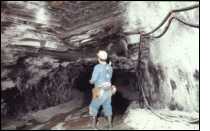Mining Topic: Horizontal Stress
What is the health and safety problem?
High horizontal stresses produce extensive and sudden rock failures. The U.S., Australian, and United Kingdom coal and the Canadian hard rock industries have long recognized the significance of high horizontal stresses as a factor affecting the stability of roof and rib conditions in underground mines.
What is the extent of the problem?
High horizontal stress is most prevalent in the Eastern and Midwestern coal beds but does occur in other locations.
How is the NIOSH Mining program addressing this problem?

Roof Fall from High Horizontal Stress
The Office of Mine Safety and Health Research (OMSHR) has been conducting research to develop a better fundamental understanding of ground control strategies through field and laboratory studies. The consequences of widening rooms, changing geology and horizontal stress, and different roof support systems have been addressed. Such specialized techniques as the "advance and relieve" plan have been studied. In this plan, horizontal stresses are relieved by removing a pillar on one side of a panel as the panel advances, creating a cave that relieves horizontal stress across the panel.
What are the significant findings?
OMSHR has developed best practices for mines encountering high horizontal stress. A software program, Analysis of Horizontal Stress Effects in Mining (AHSMN), was developed to give mine designers the optimal orientation for entries.
What are the next steps?
OMSHR is monitoring the industry to determine if there is an upswing in potentially related hazards.
See Also
- Advance and Relieve Mining: A Method to Mitigate the Effects of High Horizontal Stress on the Mine Roof
- AHSM - Analysis of Horizontal Stress Effects in Mining - 2.4.04
- Case History of the Response of a Longwall Entry Subjected to Concentrated Horizontal Stress
- Controlling Roof Beam Failures From High Horizontal Stresses in Underground Stone Mines
- Diagnosing and Controlling Moisture-Sensitive Roof in Coal Mines
- Dynamic Failure in Deep Coal: Recent Trends and a Path Forward
- Field Observations and Numerical Studies of Horizontal Stress Effects on Roof Stability in U.S. Limestone Mines
- Geologic Hazards and Roof Stability in Coal Mines
- Geophysical Methods to Detect Stress in Underground Mines
- Horizontal Stress and Longwall Headgate Ground Control
- Investigation of Pillar-Roof Contact Failure in Northern Appalachian Stone Mine Workings
- Optimizing Secondary Roof Support with the NIOSH Support Technology Optimization Program (STOP)
- Overview of Coal Mine Ground Control Issues in the Illinois Basin
- Performance Characteristics for Welded Wire Screen Used for Surface Control in Underground Coal Mines
- Performance of Roof Support Under High Stress in a U.S. Coal Mine
- Rock Falls
- Rock Mechanics Study of Lateral Destressing for the Advance-and-Relieve Mining Method
- Safer Mine Layouts for Underground Stone Mines Subjected to Excessive Levels of Horizontal Stress
- Utilizing the 'Advance and Relieve' Method to Reduce Horizontal Stress Affects on the Mine Roof, A Case Study
- Variation of Horizontal Stresses and Strains in Mines in Bedded Deposits in the Eastern and Midwestern United States
- Page last reviewed: 9/20/2012
- Page last updated: 9/22/2015
- Content source: National Institute for Occupational Safety and Health, Mining Program


 ShareCompartir
ShareCompartir